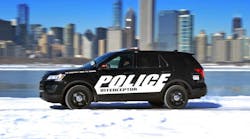Interestingly, he automaker said it developed the latest version of its police interceptor SUV with input from its Police Advisory Board, formed back in 2000, that’s made up of a rotating panel of 25 experts drawn from the law enforcement community.
Ford said this group provides a critical channel for customer feedback while also serving as a “pilot group” for police-focused products, programs and services.
As a result of that feedback, Jonathan Honeycutt – Ford’s North American marketing manager for police vehicles – said the OEM made some changes to its 2016 Ford Police Interceptor SUV package.
Those changes - along with the continuation of other "police-standard" features - include::
- First, it features a new front and rear design, new headlamps, a new instrument panel and an enhanced electrical system to distribute electrical loads more efficiently.
- New optional “surveillance mode” technology warns the driver when someone approaches the rear of the vehicle. Upon detection, the driver’s window automatically raises and all doors lock.
- A new liftgate release switch, accessible to occupants in the front, allows the rear liftgate mechanism to remain unlocked for 45 seconds before timing out – permitting officers to quickly access the cargo area.
- A rear camera with washer is standard for the 2016 model with a four-inch screen in the center stack. As an option, the view from the camera can be seen in the rearview mirror.
- In a nod to police vehicle nostalgia, Ford added a blinking white function called “wig-wag” to the incandescent high-beam light bulbs.
- Ballistic shields built to Level III specifications determined by the National Institute of Justice Standard, factory-installed in the driver and passenger doors for additional protection against gunfire.
- Available Blind Spot Information System (BLIS®), which uses two radar sensors located in the rear quarter panels to detect vehicles in the surrounding lanes. If a vehicle enters the driver’s blind spot zones, the system alerts the driver with a warning light in the side-view mirror.
- Available cross-traffic alert, which uses existing BLIS radar modules to sense oncoming traffic when slowly backing out of a parking spot. The system functions only while the vehicle is in reverse and warns when cross traffic appears within three car-widths.
- Available Reverse Sensing System, which emits an audible tone to alert the driver to certain objects up to six feet behind the vehicle.
Honeycutt added that Ford’s 2016 Police Interceptor SUV continues to come standard with a 3.7-liter V6 producing 304 hp and 279 lb.-ft. of torque, with a 3.5-liter EcoBoost V6 cranking out 365 hp and 350 lb.-ft. of torque as an option – allowing agencies to select the engine that best meets their patrol requirements, he said.
Arie Groeneveld, chief engineer for Ford’s new Police Interceptor SUV, added that all-wheel drive remains a standard feature on the 2016 iteration of this package – designed to deliver low-speed traction and high-speed handling and stability.
“Both engines have been calibrated to meet extreme test requirements defined by the Michigan State Police and Los Angeles County Sheriff’s Department,” he added. “Tests include aggressive driving on road courses and racetracks, braking and acceleration, top speed and city pursuit testing.”
Groeneveld pointed out that the standard six-speed transmission for the intHe explained that the transmission automatically switches from normal, fuel-saving operation to “Pursuit Mode” when it detects aggressive driving situations, based on brake line pressure, deceleration and lateral acceleration rates.
Once in Pursuit Mode, the upshift and downshift performance of the transmission is optimized for aggressive driving, returning to fuel-save mode when it senses the aggressive driving is complete.
The software is also “tuned” to perform a reverse J-turn, which is when a reversing vehicle is spun 180 degrees and continues, face forward, without changing direction of travel, Ford noted.
Basic design characteristics of the Police Interceptor SUV also aim to boost longevity, such as crafting into the vehicle’s 18-inch steel wheels high venting characteristics to help cool the brakes.
It also features heavy-duty powertrain mounts, reinforced sub-frame mounts and unique hubs and bearings, with larger-diameter suspension springs all helping ensure every Police Interceptor model can handle the extreme rigors of law enforcement work, Ford stressed.
Even the tires are specifically designed to meet durability and pursuit standards, with some departments logging as many as 50,000 miles per year.
Ford builds its interceptor SUVs at its Chicago Assembly Plant, but once initial work is completed, those chassis are transported less than a mile over to Troy Design and Manufacturing; a wholly-owned Ford subsidiary based in a 54,000-square-foot facility where approximately 200 workers bring Police Interceptor vehicles to life.
The OEM noted that law enforcement agencies can select from 125 different police packages from Ford, which include a variety of lighting options, wraps and styles.
In fact, Ford estimates that 269,000 police-duty accessories were installed on 36,000 vehicles before shipping to police departments across the globe in 2014 alone.
I’ll tell you one thing, though: No matter how cool it may look, I REALLY do not want to see one of these interceptors in my rear view mirror with the lights flashing. Ever!





